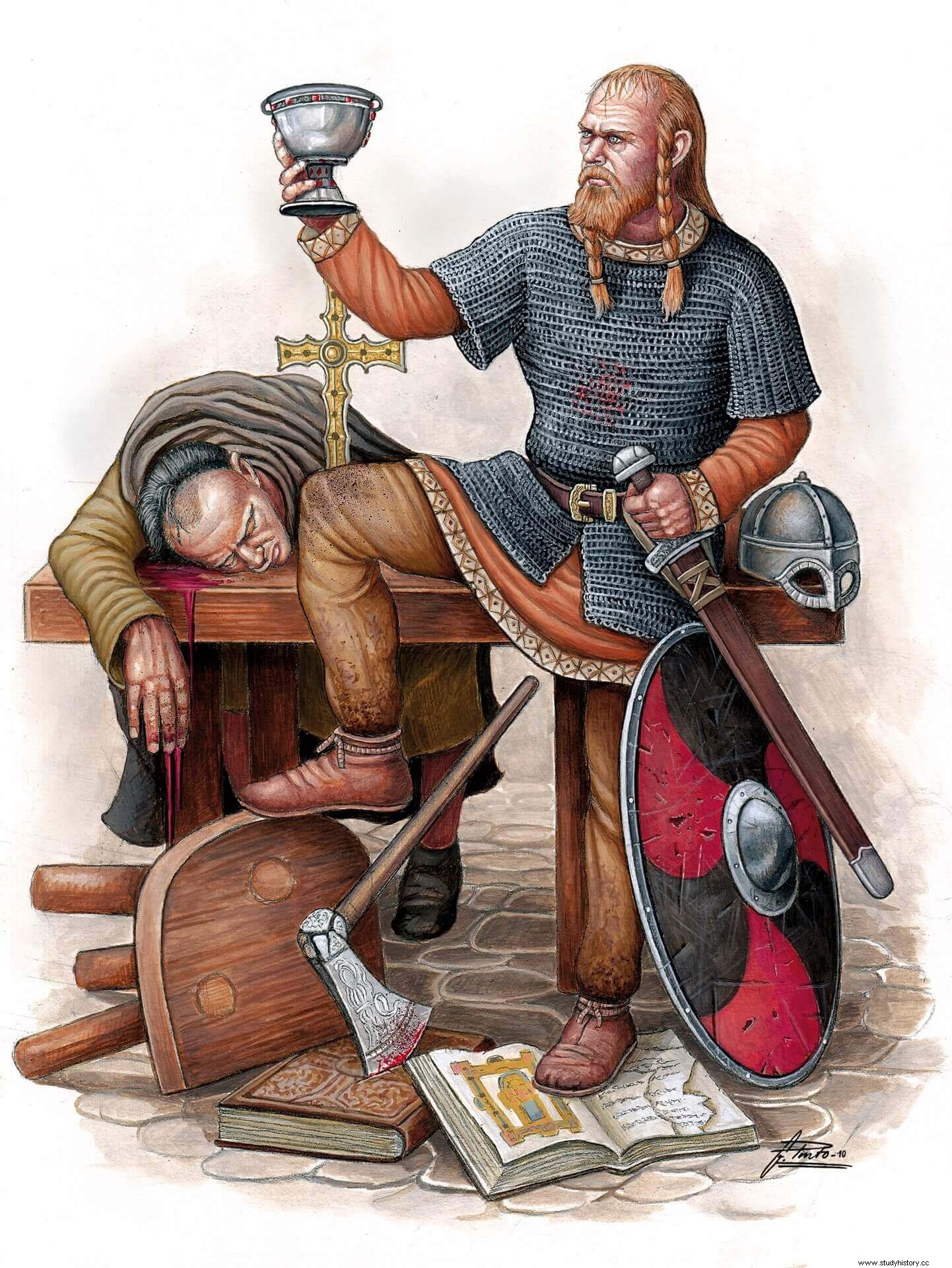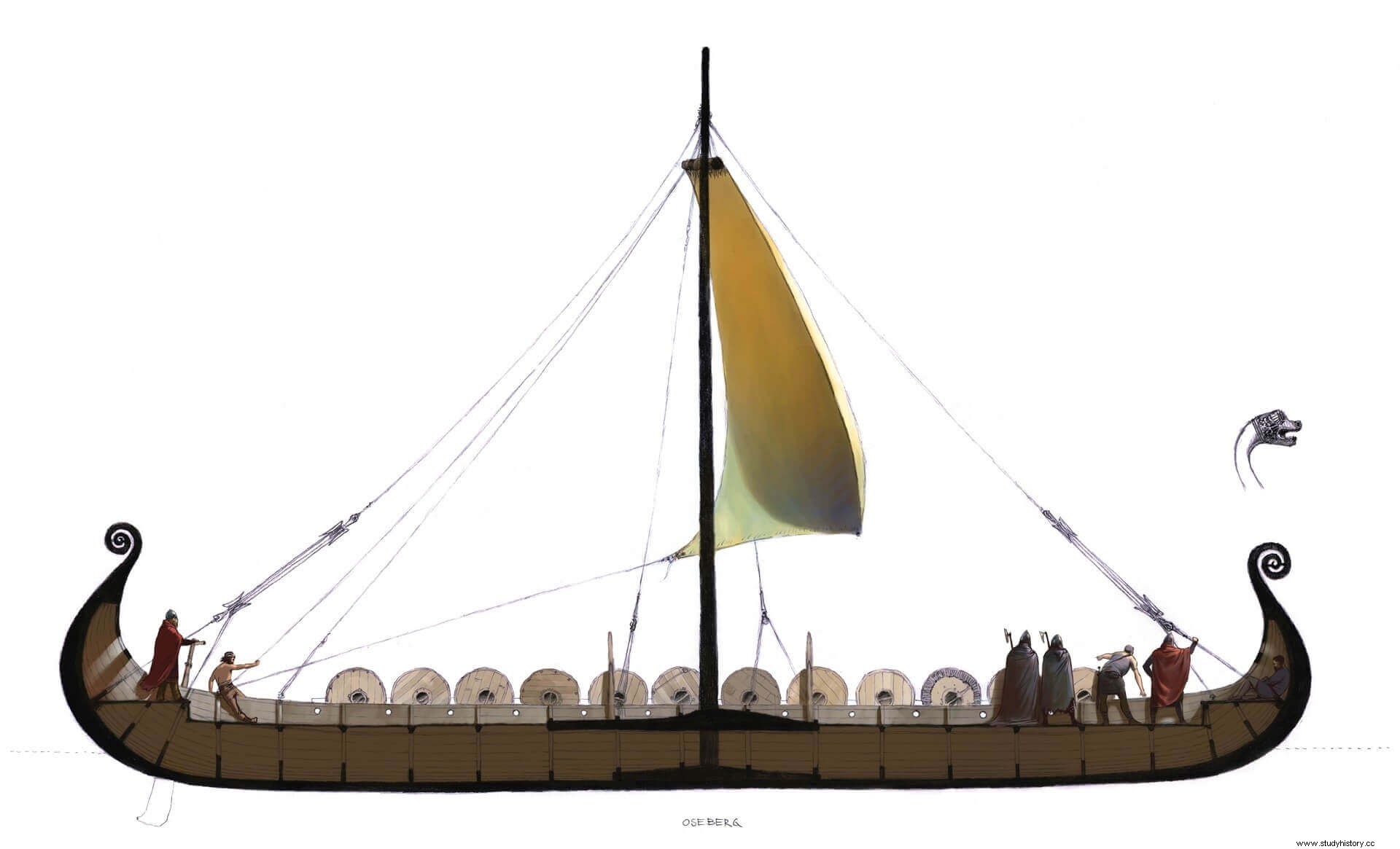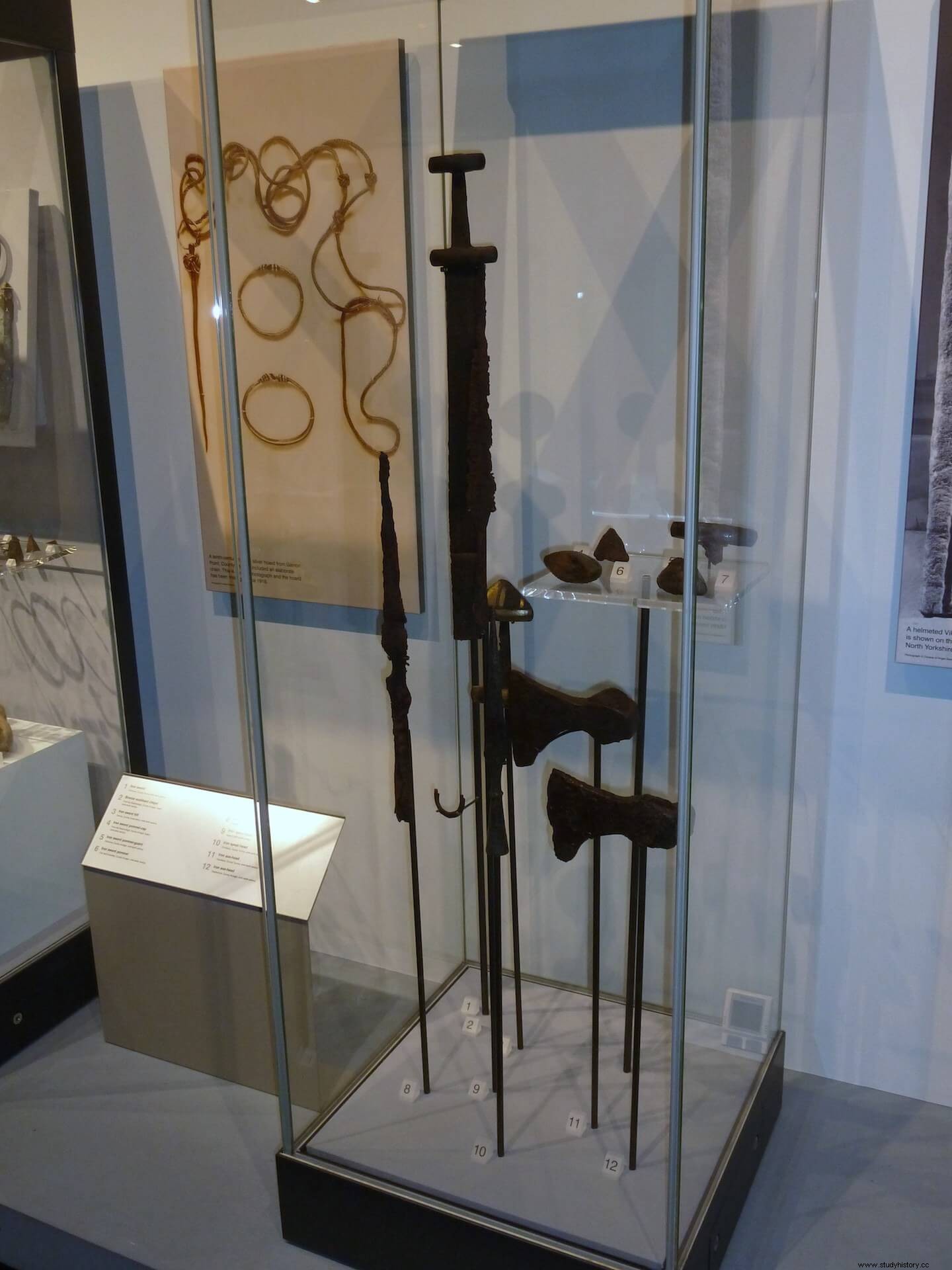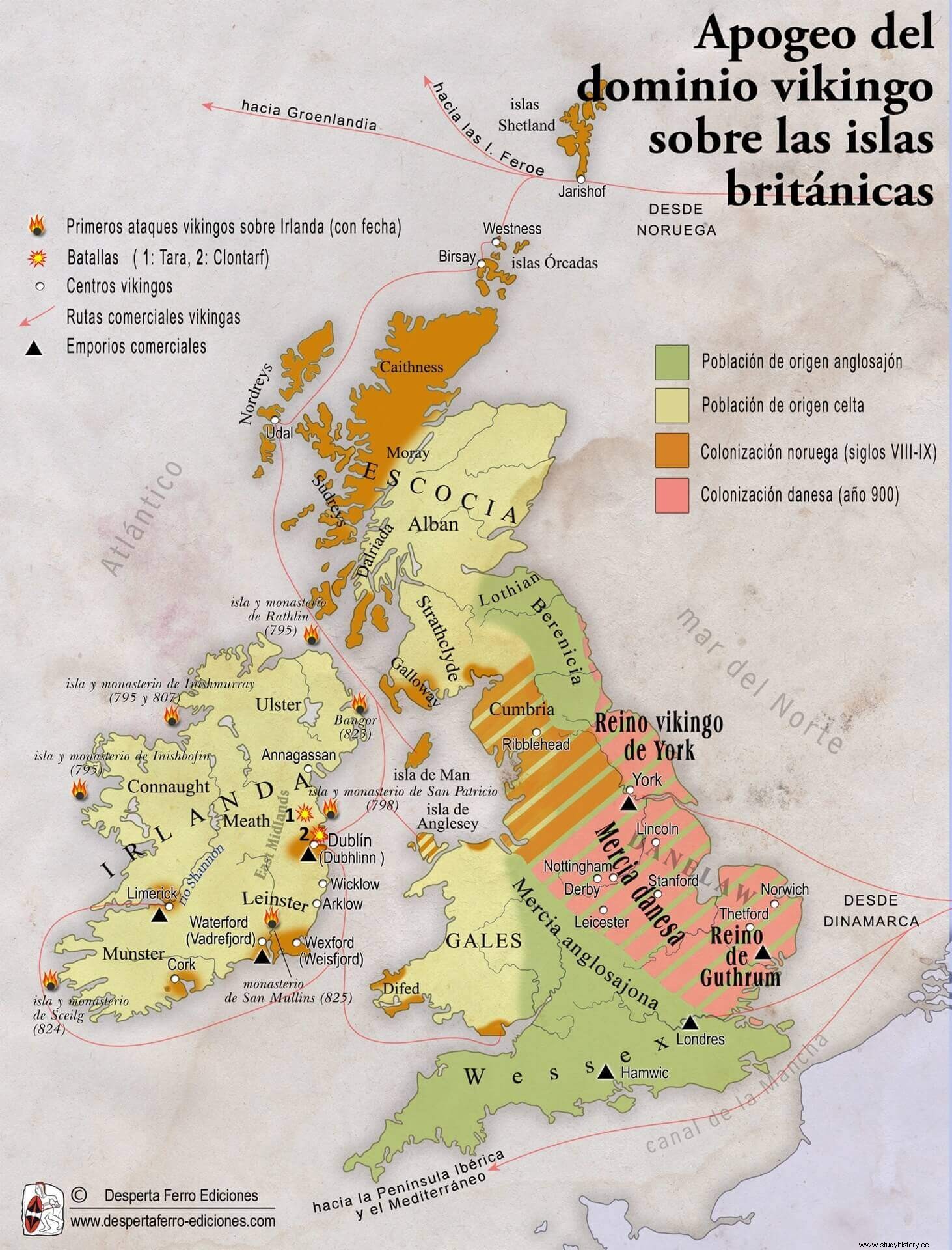
The first attack of Viking warriors in Ireland, against Rathlin Island , on the north coast, took place in 795 and raids followed one another, with uneven intensity, for the next forty years. Most Viking activity in Ireland originated in present-day Norway or from Norwegian settlements in the North Atlantic and Irish Sea areas. These first attacks were fundamentally coastal and their main objectives were churches and monasteries . The first were chosen for purely economic reasons, not religious. As for the latter, in the framework of a rural society of scattered settlements such as the Irish, the main concentrations of population, and therefore of wealth, were grouped around the monasteries and the Vikings quickly realized that their looting brought the best reward for their efforts.
As of 835 the attacks, which already included large fleets who went up the rivers to penetrate the interior of the island, began to be more organized. They built in many places fortified bases, called longphoirt –boat camps– in Irish, to allow their pillaging parties to stay longer on the island and often spend the winter there. Some of these camps became permanent settlements of the Vikings in Ireland. The most significant example is Dublin, which was born as a longphort in 841 and grew to be the first city proper and eventually to become the capital of Ireland. Dublin was the springboard for intense Viking activity in the East Midlands , the most prosperous and fertile part of the island and home to most of the wealthiest monasteries. At the end of the 9th century, Dublin emerged as the capital of a Viking maritime kingdom that included part of the east coast of Ireland, most of Scotland and the North Atlantic islands, parts of north-west England, and the Isle of Man. Dublin's activities in the East Midlands they placed it in direct confrontation with the most powerful island kingdoms until, in 902, it was decisively defeated by an Irish coalition and its sovereigns had to leave the island. Ireland was free from the Viking threat for the next twelve years, but a new period of even more virulent attacks began in 914, when a large Viking fleet arrived at the natural harbor of Waterford and established a stronghold that would become the future Waterford city. In the following years a series of settlements will be created or reoccupied, originating from Dublin, Limerick, Cork and Wexford.
Violence broke out again in Ireland, with frequent raids and battles between Viking and Irish forces with unpredictable results – the Vikings won considerable victories, but were also frequently defeated. . Ultimately, Dublin's attempts to create a great kingdom in Ireland ended in failure. The precise extent of the territories controlled by the Vikings is the subject of debate, but it must have been quite small even at the height of Viking power, in the first half of the 10th century. The “kingdom” of Dublin in Ireland it was particularly small compared to the vast areas that Dublin itself controlled in northern Britain during this period. In 953 Amlaíb (Olafr), King of Dublin, finally lost control of the city of York, and from the mid-10th century the balance of power in Ireland began to tip in favor of the Irish. Dublin's final defeat at the Battle of Tara (980) at the hands of Mael Sechnaill, King of Meath, marked the end of Viking attempts to conquer Ireland. In fact, after 980 the rest of the Viking nuclei ended up falling under the control of the different Irish kingdoms. The famous Battle of Clontarf (1014), traditionally understood as the victory that freed Ireland from Viking domination, was in fact a failed attempt by Dublin to throw off the yoke of the Irish High King, Brian Boru.
Military organization
The traditional explanation of the initial Viking success insists on the inferior military technology and the archaic politico-military structures that had prevailed in Ireland. However, some historians have disputed this claim, arguing that the more powerful Irish kingdoms – which de facto dominated the smaller neighboring kingdoms – were more advanced than previously believed. The Irish military organization before the Vikings has not been well understood. The laws obliged all free men to respond to the king's summons, both for defense and attack. In theory, this universal military obligation was the basis of most armies, as in Anglo-Saxon England or Carolingian Europe. However, in the Germanic kingdoms and in Britain, more specialized military systems developed, built around the king and his retinue. Also in Ireland, by the 9th century, military service was an exclusive privilege of the aristocracy.
On paper, the Scandinavian military organization was not very different from the Irish one. The right to bear arms was reserved for free men, responsible for rising up in defense of the kingdom. However, the proximity to the main centers of power in Europe, especially the Frankish kingdom, gave rise to a more militarized society and a greater development of military technology. Scandinavia seems to have had systems of levies and compulsory services that provided kings with the manpower and resources necessary for warfare and, over time, allowed the development of something close to a national army. The bands and armies that attacked Ireland were, however, voluntary military companies bound to their lord by a principle of mutual loyalty.
The Vikings had an inevitable impact on military organization in Ireland, fully noticeable in the 10th century but probably starting earlier. The Irish kings began to employ more and more professional soldiers andmercenaries (both Irish and Vikings). The territorial levies of the Irish kingdoms also became more professional. New procedures such as payment for military service outside the kingdom and the development of royal power to house soldiers in subjugated peoples allowed the most powerful kings to undertake increasingly remote and ambitious campaigns. In the eleventh and twelfth centuries we have evidence of the deployment of larger armies in campaigns of longer duration than before, of the considerable use of ships and cavalry, of a more limited use of castles and armor and, presumably, of the existence of a quasi-feudal warrior nobility . There is also evidence of the extension of military service and the right to bear arms to the lower classes.
There is no evidence of the warlike use of cavalry in pre-Viking Ireland. In fact, it was these who introduced the use of the horse in war to the island, although it is not clear if they used mounts only to go into battle or if they actually fought on horseback. The first reference to Irish horsemen in a military context dates back to the 850s, no doubt in reaction to the Vikings. Evidence of mounted warriors, both Irish and Viking, multiplied in the 10th and 11th centuries. It appears that the Irish nobility began to make heavy use of horses, perhaps to maintain a differentiated role in armies that now also included lower social classes.
The naval war It was not unknown in Ireland, but the Vikings certainly had a decisive impact in this area. References to sizeable fleets of between 60 and 200 Viking ships appear in Ireland in the annals of the 9th century. In the 10th century there was a huge increase in naval activity and references to Irish fleets appear for the first time. Towards the end of the 10th century, Brian Boru imitated Viking tactics by deploying fleets on the River Shannon to raid rival kingdoms, and in 1022 the King of Ulaid apparently defeated the Dublin fleet in battle on the open sea. 
By 1100 the Irish military system was, in comparable in many respects to late Anglo-Saxon England, which also included noble warriors (thengs ), mercenaries foreigners (huscarles ) and a cam general of free men (fyrd ). It is even suspected that the Irish kings, like the Anglo-Saxon kings, could demand corvées for military purposes (such as the construction and repair of bridges and fortresses). However, there is no evidence that the Irish military organization reached the levels of sophistication of the Anglo-Saxon system, especially the fyrd "chosen", a selective levy of men drawn from the districts and towns intended to provide a smaller but better equipped force than the general levy.
Military technology
Historical and archaeological sources clearly indicate that the panoply of Irish warriors at the time of the first Viking raids consisted, as in previous centuries, of spear, sword and shield as the only defence, without reference to the use of armour. The typical repertoire of Viking military equipment is well known; their main weapons were spears, swords, axes, bows and arrows. The bow and ax were the only weapons the Vikings introduced to Ireland, and while the Irish hardly adopted the bow, the ax it was used extensively – probably as a cheap substitute for the sword – and is frequently mentioned during the 11th and 12th centuries, both wielded by Irish and Scandinavian hands.
The technological quality of pre-Viking Irish equipment has been questioned, but metallography has shown that while some weapons were technologically inferior, others were of reasonable quality, with hardened edges and properly carburized.. It is difficult to link the weapons found to a particular chronological moment and virtually no Irish gun can be dated to the late 8th or early 9th century. The type of sword believed to be contemporary to the earliest Viking raids, (referred to as a “crannog sword). ”), is certainly inferior to the Viking swords of the 9th and 10th centuries. However, there is no basis for dating these swords beyond the 7th century and it is pure speculation to assume that they were still in use when the Viking raids began. When typical European swords have been found from the 9th century, it has always been assumed that they were Viking weapons, although there is a possibility that some Irish warriors were equipped with weapons comparable to those of their enemies. It seems evident that Irish warriors adopted and imitated Viking weapons , but the extent and dating of this loan are uncertain. Possibly the best Viking sword found in Ireland appeared in the crannog [N. from T.:artificial island] from Ballinderry, County Westmeath, a typically Irish site, in a 10th-century context, so it appears that this weapon was used by at least one Irish warrior.

While there are few obvious differences between the arsenal of Irish and Vikings, the use of armor makes a clear distinction between the two groups. Irish historical sources strongly state that the Irish did not wear armour, while the Vikings did, a statement that, while overly simplistic, appears to be substantially true. It is likely that at least some of the early Viking invaders were already wearing armour, and 11th and 12th century sources make frequent references to it in comparison to the unprotected Irish, sometimes justifying Irish defeats by the ineffectiveness of their weapons. against the armor of their enemies. The main term used in the sources, lúirech (from Latin lorica ), almost certainly refers to byrnie or hauberk but no material evidence of Viking helmets or armor has survived in Ireland.
The clothes that Irish warriors – even nobles – wore in battle should not differ too much from their usual attire, especially in the early Viking period. However, there are late references to the use of helmets and armor lúirecha delivered by the kings to their subordinates for their use in reciprocal military benefits. Perhaps what the sources mention is, in most cases, leather jackets or other organic materials. No doubt the Irish warriors could have obtained Viking armor through trade or combat, but in this area the loan between the two cultures was not as intense as in the case of weapons
Tactics
A general feature of the war between the Vikings and the Irish is that both large pitched battles and sieges were quite rare. The nature of warfare in medieval Ireland was strongly influenced by its particular geographical and demographic conditions. Much of the island was occupied by mountains, swamps and forests, terrain not conducive to fighting a conventional battle. And, more importantly, on an underpopulated island like Ireland, pitched battles with a high casualty rate did no one any good; the winner would take control of new territories, but there would be no resident population to cultivate them.
By contrast, the object of warfare in medieval Ireland was subjugation, not annihilation, so cattle rustling, which was of fundamental economic importance, became one of the most common resources. cattle theft led to a dynamic type of warfare, in which most engagements took place either when raiders attacked their victims as they tried to move livestock and non-combatants to safety, or when a party of plunder, back with his plunder , was in turn pursued and overtaken by enemy combatants. These tactics are reflected in Irish sources from the 9th to 12th centuries and it is clear that the Vikings would also use them.
Apart from these incursions and persecutions, there is evidence of the deliberate choice of strategic locations for military action. Attacks were usually directed against enemy camps, such as the longphoirt established by the Viking armies. A common tactic was to attack by surprise the enemy camp, usually at night, especially when victory in pitched battle did not seem assured. Many attacks or ambushes also took place at sites of restricted passage in forests, hills, and bogs. Although the evidence of this type of combat comes mostly from the 12th century, there is no doubt that these ambushes were used throughout the Viking period.

Therefore, between cattle raids and persecutions, attacks on camps and ambushes, most military activity did not involve pitched battles. The Irish relied on natural obstacles and avoided pitched battles, which, although it can be interpreted as traits of military weakness, is a reflection of their common sense and ability to take advantage of the environment. The use of natural obstacles, such as rivers, forests or bogs, in a defensive strategy was not a practice confined to Ireland but widespread throughout Europe and the Vikings themselves also avoided pitched battles unless they fully trusted victory.
When a battle finally took place, the sources shed some light on the tactics employed. The descriptions of the battle formations, although lacking in detail and full of poetic bombast, show compact masses of men in which solidity and rigidity prevailed over mobility. The information available on the actual development of the battles, which suggests minimal tactical sophistication, describes a common pattern:a preliminary exchange of projectiles from a distance – javelins, arrows and stones – followed by a close-quarters confrontation between the two armies. The use of bows by the Vikings was limited to the aforementioned preliminary exchange of projectiles. The ensuing combat was little more than an infantry melee. , usually armed with spears, swords, axes and clubs. Some accounts emphasize the importance of single combat between the main figures at the time of deciding the battle, although it may well be a mere poetic license. Most of the clashes were a test of strength between the two armies in which the aforementioned solidity, rigidity and brute force were decisive. The objective was to drive the enemy back, then break their ranks and finally make them flee. The ideal contribution of the singular warriors was to open a gap in the enemy formation, which would result in their breaking up and disbanding.
The armies they are often described as being divided into different companies for battle, usually three divisions unfolded one after the other. These three divisions may correspond to a main contingent, a vanguard, and a rearguard, although on at least one occasion they are described as being of equal size. Although more elaborate deployments are suggested in some sources, the general impression is that both the disposition of the troops and the methods of combat were rudimentary. Yet in this, too, Ireland does not appear to be much different from most of northern Europe, at least until the rise of heavy cavalry from the 10th century.
The impact of the Vikings on Ireland
How should we, therefore, assess the impact the Vikings had on Ireland? It seems difficult to explain their relative lack of success military (measured in territorial conquests) if we assume its apparent superiority at the beginning of the Viking period. However, even accepting this superiority, it would be a mistake to overestimate it and not consider that the Irish kings would have tried to compensate it quickly. No doubt it must have been difficult for the Irish to deal effectively with the isolated raids of the early 9th century, most of which saw little or no fighting, but even at this time some Irish victories are recorded. Unfortunately, the annals say nothing about the size of the forces involved or the nature of the combat, so we cannot know whether these victories were due to their military prowess, sheer numerical superiority, or other factors. In any case, these accounts help us not to underestimate the ability of the Irish to respond to Viking attacks, even at such an early time.
The ultimate military failure of the Vikings in Ireland may have been due, in part, to the fact that their conquest was never a priority for the powerful Scandinavian rulers who, in the end, They had to provide the necessary resources. On the other hand, the Vikings sowed their own ruin as a result of their leading role in the process of militarization of the main Irish kingdoms . The threat that their mere presence constituted aroused both a need for militarization and its financial basis through the wealth generated by their economic activities, and, intentionally or not, they provided much of the weaponry used in the conflict. The full effects of the militarization of the Irish kingdoms translated, from the late 10th century, into their ability to dominate and control Viking settlements.
Bibliography
- Bartlett, T. and Jeffery, K. (eds), A military history of Ireland . Cambridge University Press, 1996.
- Clarke, H.B. ‘The bloodied eagle:the Vikings and the development of Dublin, 841–1014’. Irish Sword vol. 18 (1990–92), 91–119.
- Clarke, H.B., Ní Mhaonaigh, M. and Ó Floinn, R. (eds), Ireland and Scandinavia in the early Viking age . Four Courts Press (Dublin), 1998.
- Halpin, Andrew, Weapons and Warfare in Viking and Medieval Dublin . National Museum of Ireland, Medieval Dublin Excavations 1962-81, Series B, Volume 9, 2008.
- Hjardar, Kim and Vik, Vegard, Vikings at war. Awake Ferro Editions, 2019.
